Author: Sara Gherghelas, Dapp Radar; Translator: Deng Tong, Golden Finance
Daily Dapp users reached 24.6 million, of which 32% participated in DeFi, which is the most dominant industry this year
2024 is a transformative year for the dapp industry, finally pushing us to the brink of mainstream adoption. The year marked major regulatory progress, with MiCA in Europe laying a solid foundation and Trump's election in the United States setting the stage for a new wave of institutional interest. Bitcoin's record high marked the beginning of the much-anticipated bull run, injecting new vitality into the crypto space.
Across sectors, DeFi stole the show and became the most active category. It's not just the innovation of DeFi that's driving this trend - the narrative of memecoins defined much of 2024 and gave DeFi an additional boost. Meanwhile, NFT trading and sales were both the weakest since 2020. Perhaps 2024 is the year we realize that NFTs don’t need to be expensive to prove their importance in the wider Web3 ecosystem.
2024 was the year of laying the foundation for the future. Looking ahead to 2025, we expect the industry to mature further. In the meantime, dive into this report to learn about all the exciting developments, breakthroughs, and narratives that shaped the past year.
Summary
The dapp industry saw a 485% increase in unique active wallets (UAWs) in 2024, reaching an average of 24.6 million UAWs per day by the end of the year.
Activity in the “Other” category, driven by AI dapps, grew 2,269%, highlighting the growing importance of AI in the dapp ecosystem.
DeFi activity grew 532%, with 7 million UAW per day at the end of the year and a 32% market dominance in Q4 2024.
New chains such as opBNB, Matchain, and Base made significant progress, with opBNB becoming the most used chain with 3.88 million dUAW in 2024.
DappRadar approved 5,138 new dapps in 2024, up 72% from 2023, with Games and DeFi being the leading categories.
DeFi’s total value locked (TVL) grew 211% to $214 billion in 2024, just 20% below its peak in December 2021.
New chains such as Sui, Base, and Aptos gained traction, but Solana stood out with a 2,000% increase in TVL, becoming the second-largest TVL chain after Ethereum.
NFT transaction volume fell 19% and the number of sales fell 18% compared to 2023, making 2024 one of the worst years since 2020.
Blur maintained its dominance in the NFT market, accounting for the largest market share by transaction volume for most of 2024, thanks to airdrop activity and a zero-fee transaction model.
The dapp industry suffered $1.3 billion in losses from hacks and exploits in 2024, down 31% from the previous year and the lowest amount since 2020.
Blur maintained its dominance in the NFT market, accounting for the largest market share by transaction volume for most of 2024, thanks to airdrop activities and a zero-fee transaction model.
The dapp industry suffered $1.3 billion in losses from hacks and exploits in 2024, down 31% from the previous year and the lowest amount since 2020.
Table of Contents
Industry-wide expansion: a record year for UAW growth
DeFi nears all-time highs: TVL reaches $214 billion in 2024
NFT market has its worst performance since 2020
A year of reduced losses but persistent threats
Conclusion
1. Industry-wide expansion: a record year for UAW growth
The dapp industry experienced incredible growth in 2024, with unique active wallets (UAW) increasing by 485%. By the end of the year, this surge meant an average of 24.6 million daily UAWs.

The most notable growth was seen in the “Other” category, which saw a significant increase in activity by 2,269%. This surge can be attributed to the rise of AI dapps, which led to the launch of a dedicated AI dapp ranking on DappRadar. Originally, the “Other” category was an umbrella term for emerging or poorly defined dapps, including early AI solutions. Over time, AI dapps have gained significant traction, demonstrating their transformative potential and prompting them to become a separate category.
DeFi came in second with 532% growth in activity, ending the year as the most dominant category with 7m UAW per day and a 32% market share in Q4 2024. This was driven by memecoins and AI agent coins, which made a lot of noise throughout the year.
Meanwhile, blockchain games came in third with 421% growth. While DeFi’s dominance fluctuated between 26-29% throughout the year, DeFi overshadowed games in Q1 and Q4 2024.
The NFT sector grew 412%, driven by the airdrop narrative, while the social sector (still emerging) saw a 70% increase in activity. Despite the modest increase, social dapps may gain more attention in 2025.
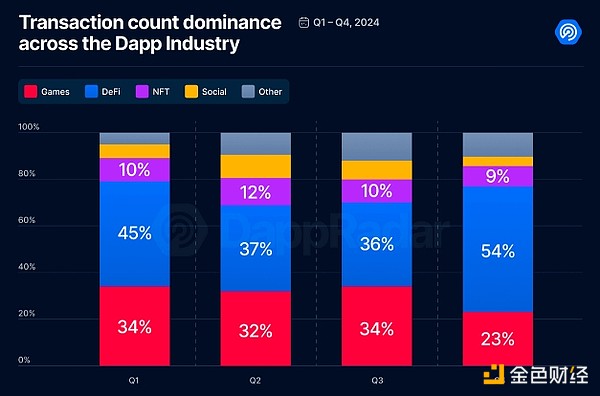
Transaction analysis reveals a different picture. Social dapps saw the highest transaction growth, up 455%, mainly due to task platforms, where users must complete tasks on or off-chain to receive rewards. Game transactions fell 16% since the beginning of the month, but still achieved more than 5 billion transactions this year. This shift may indicate that games are moving more off-chain rather than on-chain.
DeFi has seen over 8 billion transactions this year, up 66% from the previous year, dominating total volume at 54%. This is consistent with trends we’ve observed - meme transactions, newly launched on-chain tasks that promise rewards, and a notable uptick in activity last quarter as rumors of a new bull run began to gain traction.
Blockchain Performance: Emerging Stars and Top Blockchains in 2024
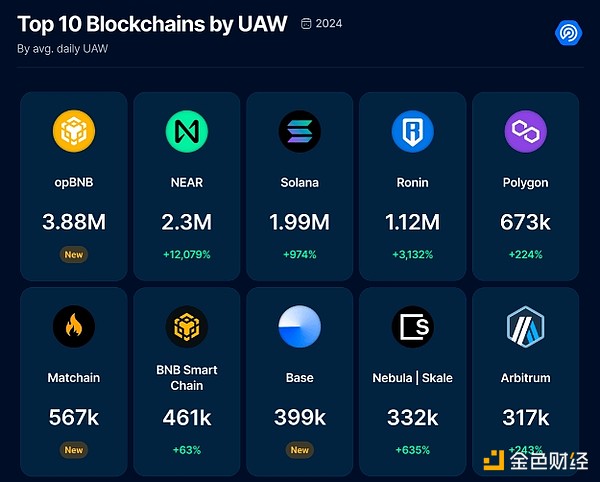
Of these chains, opBNB emerged as the most used chain, which utilizes Optimistic Rollup technology to enhance scalability and reduce transaction costs. Particle Network is the leading dapp on the chain.
Newcomers Matchain and Base also achieved success. Matchain rose in the rankings with the LOL dapp as its top performer, while Base hit a record high with $15.65 billion in Uniswap V3 trading volume in 30 days.
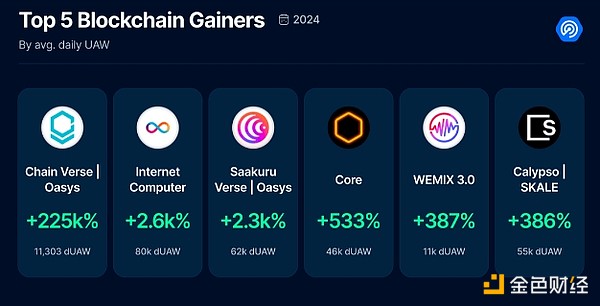
While the largest blockchains always steal the show, we are also seeing a lot of growth in smaller ecosystems. Above we list the six blockchains with the largest increases in average daily unique active wallets. This list includes Oasys, Internet Computer, Core, WEMIX 3.0, and SKALE. Dapps such as video game application ChainArena on Oasys, social email platform Dmail Network on ICP, and gaming platform Pixudi on Core contributed to these increases, reflecting the diverse growth of the ecosystem.
DappRadar Metrics Defining 2024
However, as DappRadar aims to be the global Dapp store, we decided to take a look at some metrics to see what the trends were this year and what we’ll see next year. DappRadar approved 5,138 dapps through its developer dashboard in 2024, a 72% increase from 2023, which is consistent with the fact that we’ve seen more and more dapps enter the mainstream this year. Games accounted for 31.1% of these, followed by DeFi at 18.7%, highlighting their dominance as the main trend this year.
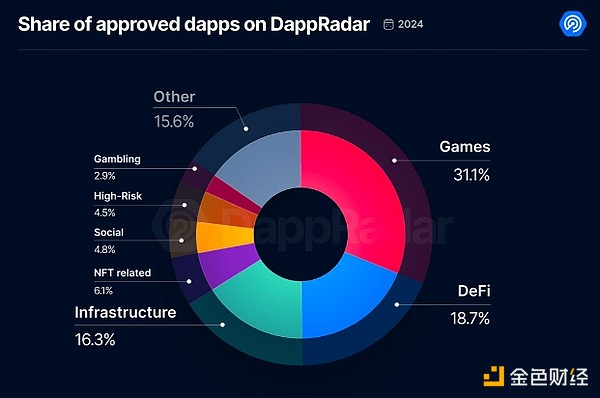
According to DappRadar’s page views, the top dapps in 2024 are mainly games. Their continued presence in the rankings highlights the strength and engagement of their communities.
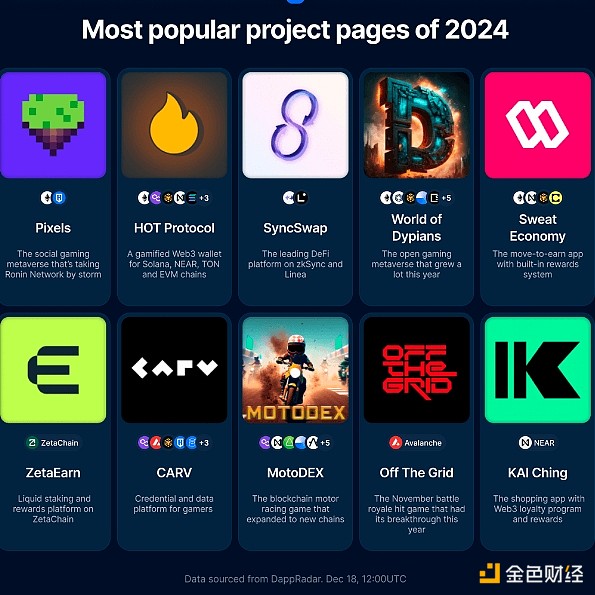
2. DeFi Approaches All-Time Highs: TVL Reaches $214 Billion in 2024
This year, the DeFi sector has become a cornerstone of the dapp industry, as highlighted in Chapter 1. DeFi has been the strongest performer, with total locked value (TVL) growing 211% to close 2024 at $214 billion, just $47 billion shy of its December 2021 peak.
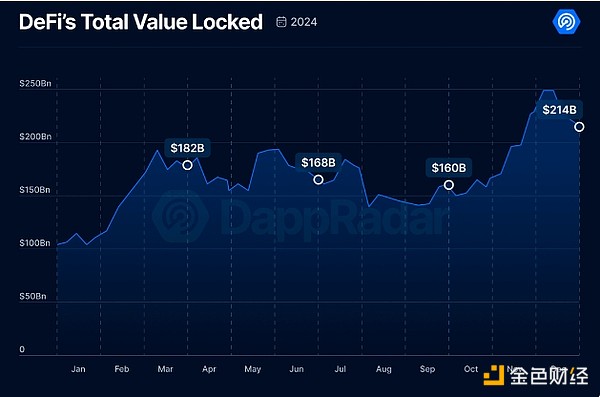
Several key factors have contributed to the remarkable success of DeFi this year. First, the hype of Meme coins played an important role. The rise of Meme coins such as GOAT and PEPE brought a surge in trading activity and liquidity to DeFi platforms, attracting the attention of traders and speculators.
In the second half of the year, the introduction of AI agents brought a transformational layer to the ecosystem. These AI-driven agents facilitate tasks like trading and governance, streamlining operations and driving user engagement. This innovation is likely to be further explored and expanded in 2025, positioning AI as a core component of DeFi’s development.
Finally, the Federal Reserve’s rate cuts have reignited interest in DeFi lending protocols. In a low-interest environment, investors have turned to platforms like Aave and Compound for higher returns, leading to a significant increase in lending activity.
In addition, Bitcoin hit an all-time high of $108,000 in mid-December 2024, driven by major regulatory milestones. In January, the U.S. Securities and Exchange Commission (SEC) approved multiple spot Bitcoin ETFs, including BlackRock’s iShares Bitcoin Trust (IBIT). IBIT quickly became the first spot Bitcoin ETF with a trading volume of more than $1 billion as of January 19, 2024. On this basis, the SEC subsequently approved a spot Ethereum ETF, and institutions such as Fidelity also launched their own products.
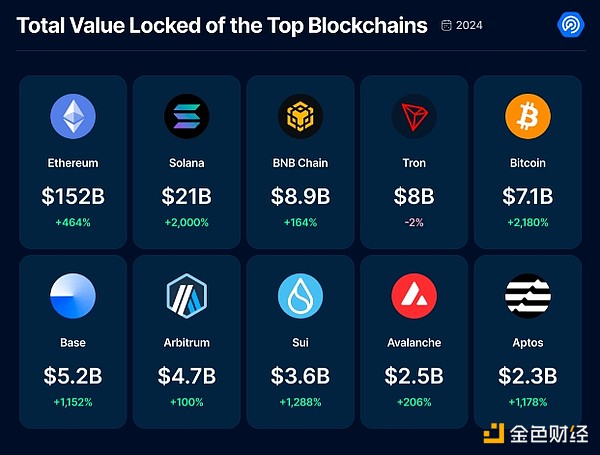
Newer blockchains such as Sui, Base, and Aptos have performed well in the year, launching multiple updates and becoming the focus of attention. However, Solana stole the show, rebounding from a challenging 2023 to achieve a staggering 2,000% increase in TVL, becoming the #2 blockchain by TVL. This recovery solidifies Solana’s redemption arc and highlights its resilience.
A lot happened in 2024. The DeFi industry firmly established itself as a transformative force in finance through innovation, institutional adoption, and regulatory advancements.
Top Trends Impacting DeFi in 2024
Memecoins: In 2024, memecoins such as GOAT, PEPE, and ShibaDoge reignited retail interest, driving liquidity and activity on DeFi platforms. These highly speculative tokens often serve as a gateway for users exploring DeFi for the first time.
AI Agents: The rise of AI-driven agents has revolutionized DeFi by automating complex operations such as yield farming, arbitrage, and governance voting. These agents increase efficiency, reduce human error, and allow users to optimize returns with minimal effort.
Tokenization of Real World Assets (RWAs):DeFi continues to bridge traditional finance with decentralized systems, unlocking new liquidity and investment opportunities through tokenized assets such as real estate and commodities.
Layer2 Solutions:Optimism, zkSync, Arbitrum, and Base have gained greater traction by addressing scalability and reducing transaction costs.
Bitcoin Layer2 Solutions:The growth of the Bitcoin network has facilitated the creation of dapps on Bitcoin, expanding its functionality beyond value storage.
Points and Airdrops:Projects use point systems and airdrops to incentivize user participation, promoting community engagement and loyalty in the DeFi ecosystem.
Sustainability:DeFi platforms have adopted environmentally friendly protocols that meet ESG standards, attracting environmentally conscious investors.
Cross-chain interoperability:Seamless transfers across networks expand the capabilities of DeFi. Interoperability solutions enable users to access a variety of liquidity pools and decentralized services without the limitations of a single chain.
Regulatory developments and institutional involvement
In 2024, the regulatory landscape has evolved significantly, especially in the United States and Europe, with frameworks such as the EU Markets in Crypto-Assets (MiCA) regulation providing much-needed clarity.While these regulations present challenges, they mark a key step toward industry maturity and wider adoption. Institutional interest has surged, and DeFi has further diversified through innovations in prediction markets, lending, and financial instruments.
MiCA’s key impacts on cryptocurrencies:
Clear rules for cryptocurrency businesses, ensuring legal certainty.
Strengthen consumer protection through stablecoin regulations.
Require crypto service providers to obtain licenses and improve security.
Address market manipulation and insider trading issues and enhance trust.
Promote global regulatory coordination to pave the way for wider adoption.
As DeFi enters 2025, the industry is expected to stabilize, with clearer regulation, further integration of risk-weighted assets, and technological advances such as zero-knowledge proofs that will improve security and scalability. DeFi still has the potential to redefine global finance, providing transparent, inclusive and efficient services while connecting traditional and decentralized economies.
3. NFT market performance hits a new low since 2020
The NFT market in 2024 has experienced severe fluctuations. At the start of the year, trading volumes surged to around $5.3 billion in Q1, up 4% compared to Q1 2023. However, this momentum was short-lived, as trading volumes fell to $1.5 billion in Q3 before rebounding to $2.6 billion in Q4. Despite these fluctuations, a closer look at NFT sales tells a different story: Sales numbers are lower than in 2023, highlighting that NFTs are generally more expensive in 2024, in line with rising token prices, especially for ETH.
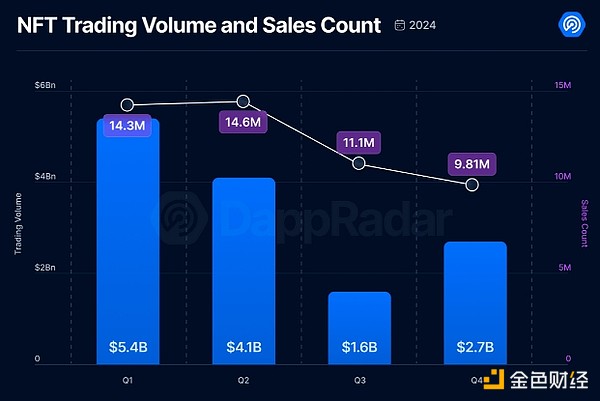
On an annual basis, NFT trading volume fell 19% compared to 2023, and NFT sales fell 18%. This makes 2024 one of the worst performing years in terms of trading volume and sales since 2020.
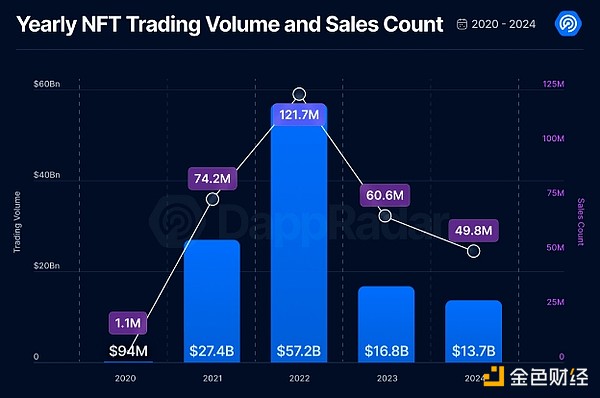
Top NFT Collectibles: A Shift in Dominance
Pudgy Penguins took the lead in terms of trading volume, but sales were down 44%. Interestingly, their reserve price increased by 114%, reflecting the impact of a major effort made in 2024. They have launched plush toys in major retailers such as Walmart, Walgreens and Target across the US, and Selfridges and Argos in the UK. In May 2024, they partnered with Mythical Games to develop a blockchain mobile game that aims to merge their popular penguin characters with a high-quality gaming experience. In September 2024, Pudgy Penguins partnered with Spanish football club CD Castellón to become the first PFP NFT to appear on a professional football team's jersey. This reinforces the idea that NFTs with real-world utility continue to perform well.
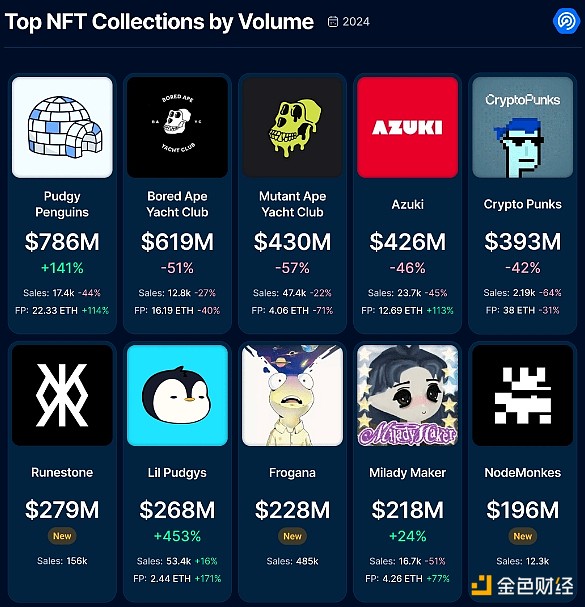
Yuga Labs' series, while still one of the most traded, has seen a decline in dominance and FP has been severely affected. Despite the challenges, Yuga Labs has plans for 2025 to focus on its immersive metaverse platform Otherside and launch new projects in partnership with PP Man. This commitment to innovation will likely shape their future trajectory.
Gaming Industry Dominates NFT Sales

In terms of sales volume, gaming-related NFTs clearly dominate. This trend reflects the gaming industry’s growing adoption of NFTs, which give players true ownership of in-game assets and facilitate player-driven economies.
Platform Performance: Blur vs. OpenSea
Speaking of platforms, Blur maintained its market dominance throughout 2024, with the exception of Q3. By Q4, Blur and OpenSea were neck and neck in market share. Blur’s success was fueled by multiple airdrop campaigns and its zero-fee trading model, which attracted cost-conscious traders.
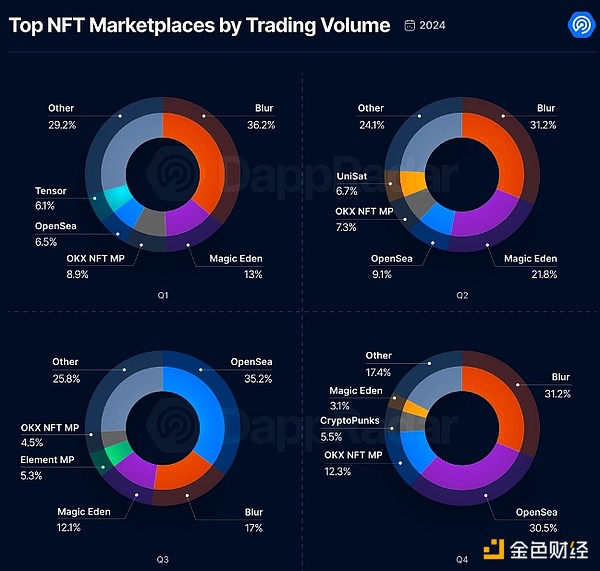
OpenSea had a challenging year. In August 2024, the U.S. Securities and Exchange Commission (SEC) issued a Wells Notice to OpenSea, citing concerns about unregistered securities. Coupled with a declining market and intense competition, OpenSea announced a massive layoff in November, reducing its staff by 56%. The company is currently focusing on "OpenSea 2.0" to regain market share and revitalize its platform, while hinting at a possible token launch.
Meanwhile, Magic Eden has outperformed OpenSea. Initially focused on Solana, Magic Eden has since expanded to include Ethereum, Polygon, Bitcoin, and emerging networks such as Base and Arbitrum. On December 10, 2024, Magic Eden launched its native ME token and conducted a $700 million airdrop to enhance its ecosystem.
Broader Ecosystem Trends and Future Outlook
The NFT ecosystem has diversified its use cases, gaining traction in areas such as gaming, music, real estate, and real-world applications such as ticketing. Environmental concerns have driven platforms to adopt sustainable blockchain solutions, while layer 2 scaling solutions such as Polygon and zkSync have increased transaction efficiency and reduced costs. Regulatory pressure has highlighted the need for clearer compliance standards, signaling a maturing market.
Looking ahead, 2025 is expected to be a year of consolidation and innovation. Mainstream adoption is likely to grow, driven by improved user experience, broader utility in areas such as supply chain management and digital identity, and more robust secondary markets. With regulatory clarity, technological advances such as AI integration, and enhanced smart contracts, the NFT industry is expected to redefine digital ownership and continue to be a cornerstone of Web3.
4. A year of fewer losses but persistent threats
Security challenges remain a major concern for the dapp industry in 2024. According to the REKT database, the industry suffered up to $1.3 billion in losses from hacking attacks and vulnerability exploits. While this figure is still considerable, it is down 31% from the previous year and the lowest loss amount so far in 2020.
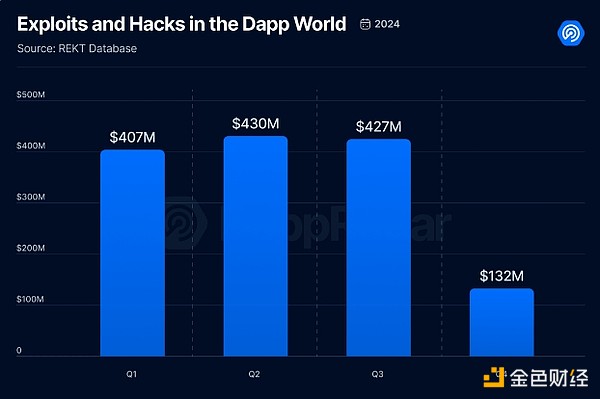
The fourth quarter of 2024 was the quietest quarter of the year, with the least losses from hacking and vulnerabilities. In contrast, losses in other quarters have hovered around the $400 million threshold, highlighting the continued fragility of the ecosystem.
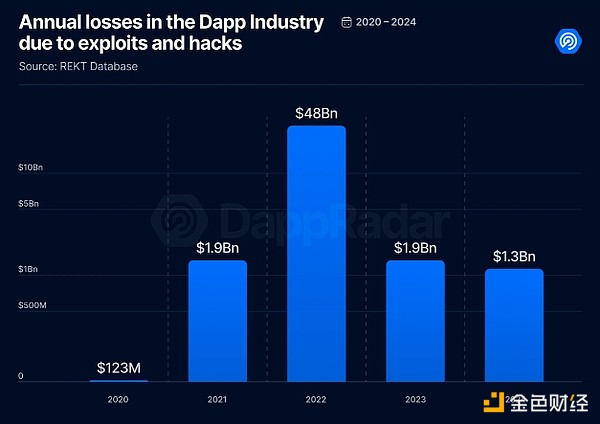
Among the affected blockchains, Ethereum topped the list, accounting for 49.3% of the total losses, followed by BNB chain, accounting for 22.5%. Ethereum's dominance in the DeFi ecosystem makes it a prime target for complex attacks such as flash loan vulnerabilities and reentrancy attacks. Its complex smart contracts, frequent upgrades, and reliance on vulnerable cross-chain bridges further exacerbate the risks.
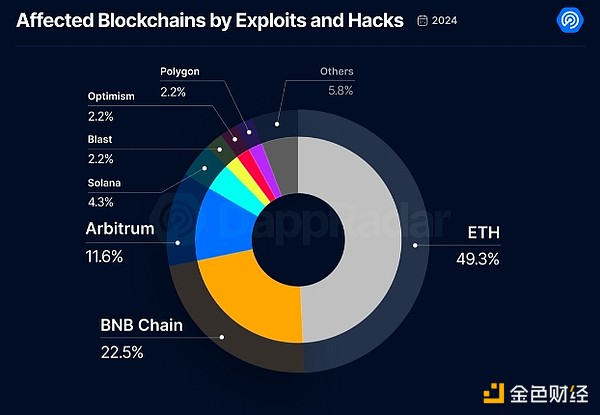
Access Control: The Most Common Attack Vector
Access control vulnerabilities became the most prevalent attack vector in 2024. This occurs when an attacker exploits weaknesses in a system’s access control mechanisms to gain unauthorized access to resources, data, or functionality.
Rugpulls also continue to plague the Web3 space, fueling suspicion and eroding trust in the ecosystem. Despite efforts to mitigate their impact, these scams remain an ongoing problem.
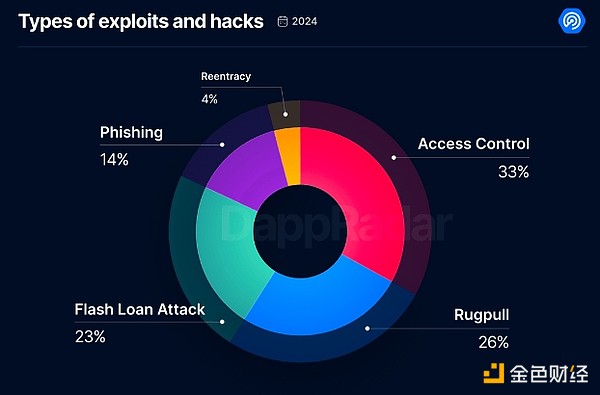
The most significant achievements in 2024
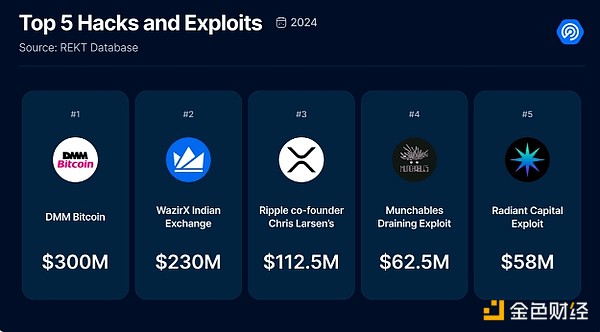
Among the most influential attacks of the year, the following events stand out:
DMM Bitcoin CEX Breach: Centralized exchange hacked, $300 million lost.
WazirX Indian exchange breach: WazirX major breach, $230 million lost.
Ripple co-founder breach: Hackers stole $112.5 million from Chris Larsen’s crypto assets.
Munchables drain breach: Munchables platform lost $62.5 million due to breach.
Radiant Capital breach: Breach against Radiant Capital resulted in $58 million loss.
As the Web3 space continues to grow, security challenges will continue to be a major concern. At DappRadar, we always recommend that users prioritize the security of their funds by staying informed about potential scams and breaches. Use a trusted platform, enable multi-factor authentication, and be cautious of offers that seem too good to be true. Remaining vigilant is essential to safely navigating the evolving dapp ecosystem.
5. Conclusion
The 2024 Dapp Industry Report documents a year of remarkable progress, challenges, and innovations in the blockchain ecosystem. From the explosive growth of DeFi and the rise of AI-driven dapps, to the volatility of the NFT market and the ongoing security battle, the industry has demonstrated resilience and adaptability. These developments highlight the tremendous potential of Web3 to reshape industries and create new opportunities.
As we move into 2025, the focus will likely shift to refining these innovations, achieving greater regulatory clarity, and driving mass adoption. With advances in scalability solutions, enhanced security measures, and a wider range of use cases, the decentralized space is poised for another groundbreaking year.
 Kikyo
Kikyo





















